To make every grain count, start by knowing your rice varieties and their cooking ratios. Rinse before cooking to remove excess starch, and avoid stirring to keep it fluffy. A heavy-bottomed pot helps prevent scorching, and toasting rice can enhance flavor. Don’t forget to season with salt for taste. Use a kitchen towel under the lid to absorb moisture and let it rest after cooking for perfect texture. There’s so much more you can master!
Key Takeaways
- Rinse rice until water runs clear to remove excess starch, preventing clumping and stickiness.
- Toast rice in a little oil for 3-5 minutes to enhance flavor and aroma before adding water.
- Use the proper water-to-rice ratio: 2:1 for white rice, 2.5:1 for brown rice, and 1.5:1 for basmati.
- Let rice rest for 15 minutes after cooking to redistribute moisture and achieve fluffy, consistent grains.
- Place a kitchen towel between the pot and lid during cooking to absorb excess moisture and prevent sogginess.
Know Your Rice Varieties
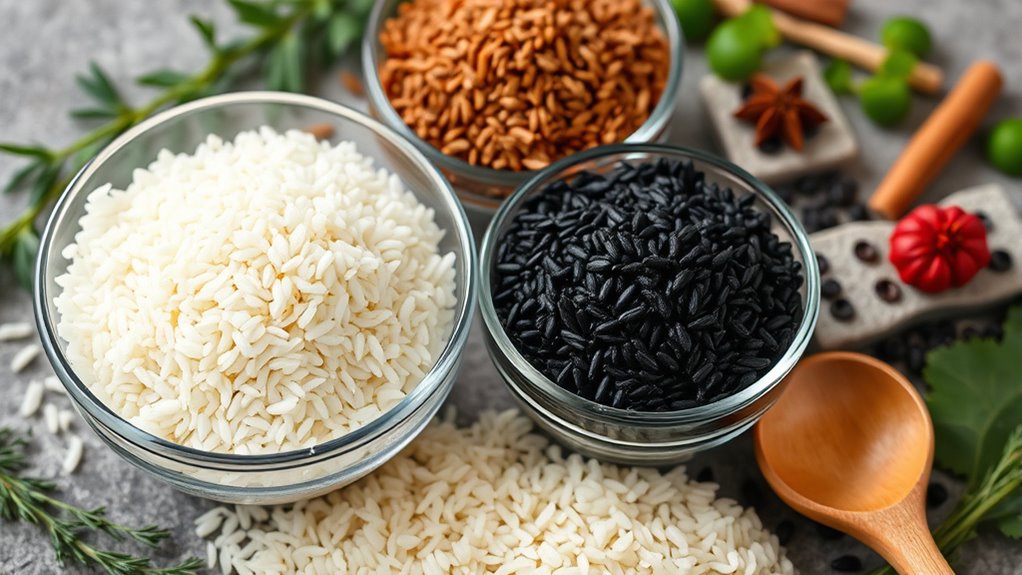
When you immerse yourself in the world of rice, understanding the different varieties can make a big difference in your cooking.
Short grain rice, for instance, is plump and sticky, making it perfect for sushi and sticky rice bowls. In contrast, long grain rice remains fluffy and non-sticky, ideal for pilafs and salads.
Each rice variety has unique textures and flavors, so substituting one for another mightn’t yield the results you expect. Basmati rice adds an aromatic touch to Indian dishes, while brown rice offers more fiber and nutrients.
Even wild rice, a seed with a nutty flavor, enhances salads and soups. Familiarizing yourself with these rice varieties can elevate your culinary creations considerably.
Understand Cooking Ratios
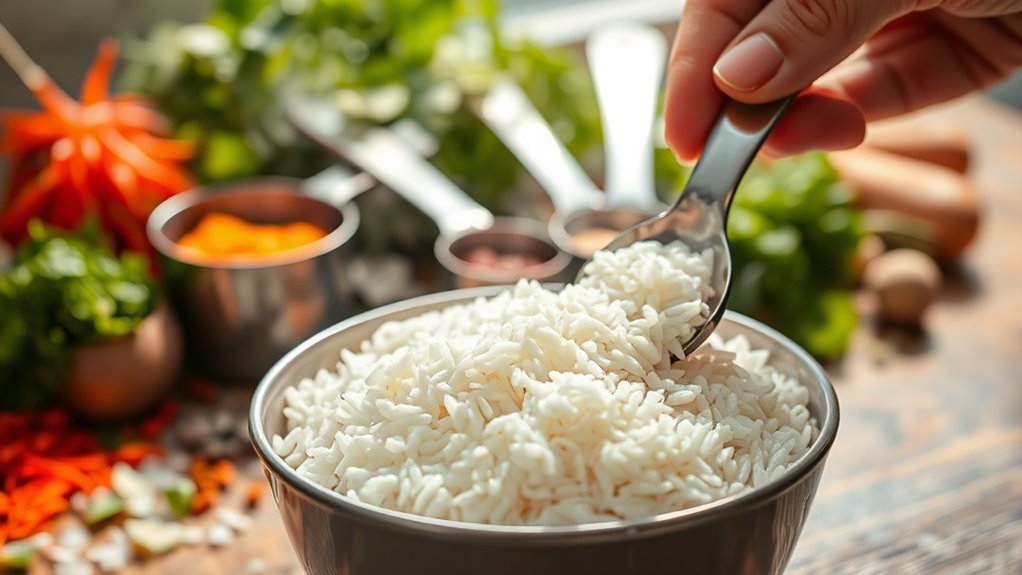
When cooking rice, understanding the right water-to-rice ratio is essential for perfect results.
For instance, white rice typically needs 2 parts water to 1 part rice, while brown rice requires up to 3 parts water.
Adjusting these ratios based on the type of rice you’re using will help you achieve the desired texture every time.
Rice Water Ratio Guidelines
Understanding the right water-to-rice ratio is essential for achieving perfectly cooked rice every time. Here’s a quick reference to help you master the rice water ratio for various types:
| Rice Type | Water Ratio | Notes |
|---|---|---|
| White Rice | 2:1 | 2 cups water per cup rice |
| Brown Rice | 2.5:1 to 3:1 | Requires more cooking time |
| Basmati Rice | 1.5:1 | Best for fluffy texture |
When cooking perfect rice, remember that using alternative liquids like broth can alter the water ratios needed. Also, different cooking methods may affect the texture, so adjust accordingly. With these guidelines, you’ll be well on your way to rice perfection!
Adjusting for Rice Varieties
Adjusting your cooking ratios is essential for achieving the perfect texture, especially when working with different rice varieties. Each type has its own ideal water-to-rice ratios.
For example, long grain rice typically needs a 2:1 ratio, while brown rice might require 2.5:1 or even 3:1 due to its longer cooking time. Basmati rice stands out with a 1.5:1 ratio.
When switching between grain varieties, remember that short grain rice, which tends to be sticky, won’t yield great results if you use the ratios meant for long grain or basmati.
Always consult cooking charts for lesser-known rice types, as their requirements can vary greatly. If you’re using broth or coconut milk, adjust the water-to-rice ratios accordingly to maintain flavor and texture.
Rinse Rice Before Cooking
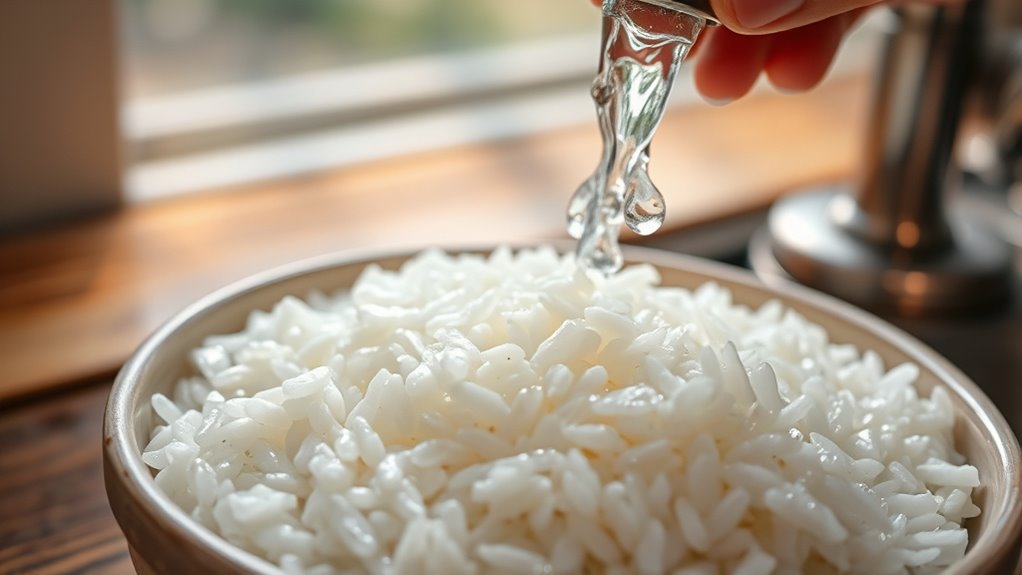
Rinsing rice before cooking is a simple yet effective way to enhance your dish’s texture. By rinsing rice, you remove excess starch that can cause clumping and stickiness. A quick rinse in cold water can make a noticeable difference in the final result. Here’s a quick guide to help you:
| Step | Action |
|---|---|
| 1. Measure Rice | Use desired amount of rice |
| 2. Place in Strainer | Use a fine-mesh strainer |
| 3. Rinse | Run cold water while agitating gently |
| 4. Check Water | Rinse until water runs clear |
| 5. Cook | Proceed with your cooking method |
For starchy varieties like sushi rice, multiple rinses may be necessary. This small effort guarantees perfectly cooked rice every time!
Avoid Stirring While Cooking
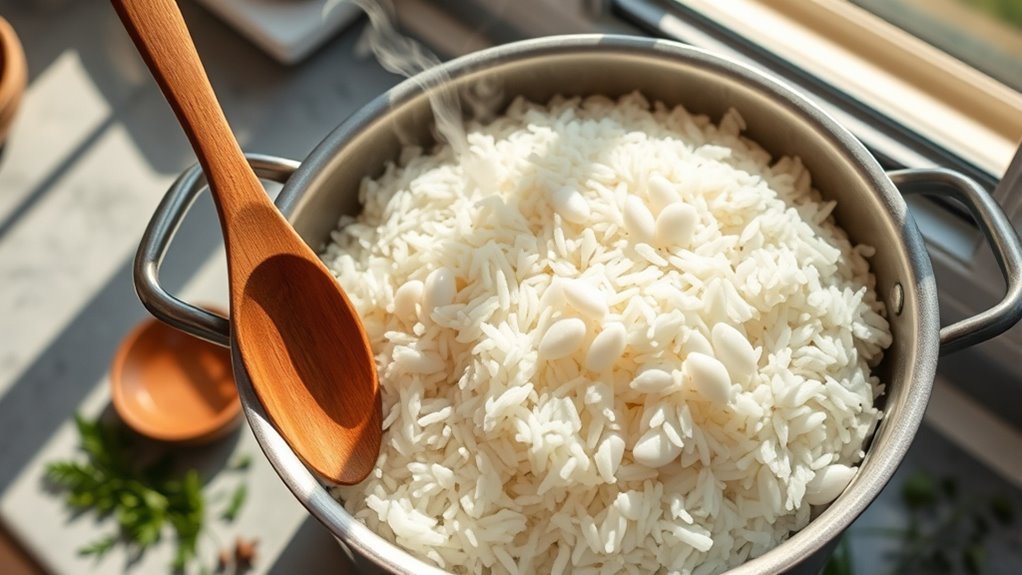
While it’s tempting to stir rice as it cooks, doing so can lead to a gummy texture that most people want to avoid. Avoiding stirring is an essential step in achieving fluffy, well-separated grains.
When you stir, you release excess starch, making the rice dense and unappetizing. Instead of reaching for a spoon, focus on proper heat management. Bring the water to a boil and then reduce the heat to a simmer. Let the rice cook undisturbed for the entire duration.
After cooking, resist the urge to stir again; instead, let it rest. This simple act redistributes moisture evenly, enhancing the final texture and ensuring your rice is light and fluffy—exactly how it should be!
Use a Heavy-Bottomed Pot

Achieving perfectly cooked rice goes beyond just avoiding stirring; it also involves using the right equipment. A heavy-bottomed pot is essential for this task. It distributes heat evenly, preventing scorching and ensuring consistent cooking results.
Unlike thin pots, which can create hot spots and lead to burning, a heavy pot maintains temperature stability. This stability allows you to focus on other parts of your meal without constant monitoring. Dutch ovens are particularly effective, as their design conducts heat uniformly, making them ideal for cooking rice.
Add Oil to Prevent Sticking
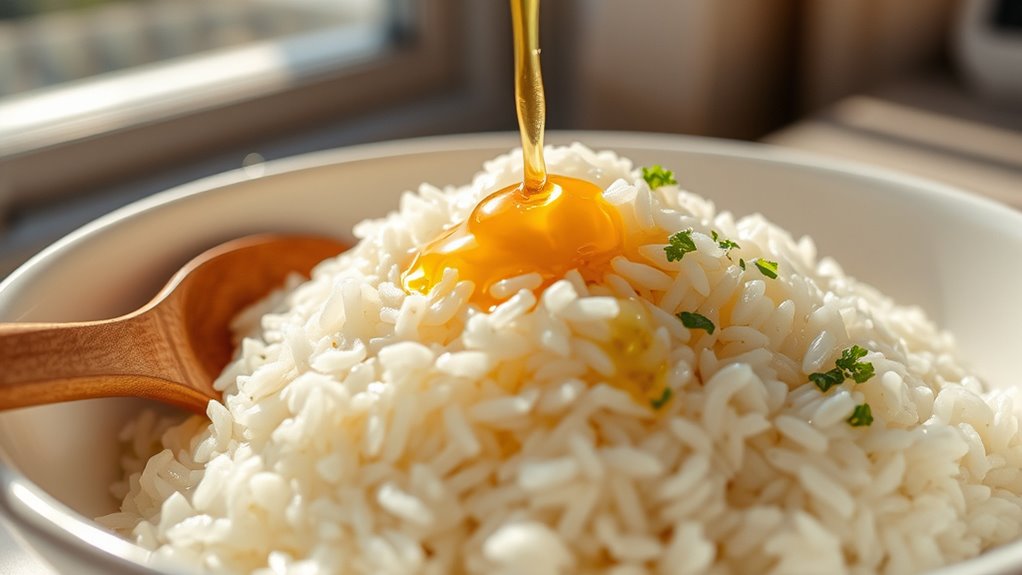
Adding a splash of oil to your rice not only prevents sticking but also enhances flavor.
You’ll find that about one tablespoon per cup of rice is just right for achieving that perfect texture.
Plus, experimenting with different oils can elevate your dish with unique tastes and health benefits.
Oil Variety Options
To guarantee your rice comes out fluffy and separate, incorporating a tablespoon of oil or butter into the cooking liquid is key.
Using different oil variety options can enhance your rice while preventing sticking. For a Mediterranean twist, try olive oil; it adds richness without overpowering the dish. If you’re looking for an Asian flair, sesame oil can infuse a unique taste.
Coconut oil not only helps with separation but can also cut calorie content considerably. For an extra flavor boost, consider using garlic-infused or herb-infused oils.
Experimenting with these oils allows you to create diverse textures and flavors, transforming your rice dishes into delightful culinary experiences. Enjoy the versatility they bring to your meals!
Flavor Enhancement Benefits
When you incorporate a splash of oil or butter into your rice cooking process, you’ll notice a significant improvement in texture and flavor. This simple addition not only prevents rice grains from sticking together but also enhances the overall taste. With approximately one tablespoon of oil per cup of rice, you can create defined grains perfect for salads or side dishes.
| Type of Oil | Flavor Profile | Best Use |
|---|---|---|
| Olive Oil | Fruity and robust | Mediterranean dishes |
| Coconut Oil | Sweet and tropical | Asian cuisine |
| Sesame Oil | Nutty and aromatic | Stir-fries |
Experimenting with different oils can lead to delightful flavor enhancement, making each rice dish a unique culinary experience.
Ideal Oil Amount
A tablespoon of oil or butter can make a noticeable difference in your rice cooking routine. Adding this small amount to the cooking liquid helps separate the rice grains, resulting in a less sticky texture that’s perfect for salads and side dishes.
You can choose different oils to enhance flavor; for instance, olive oil gives a fruity note, while coconut oil adds a hint of sweetness. The oil coats the rice grains, preventing them from clumping together, especially beneficial for long grain varieties.
This simple technique not only improves the texture but also enriches the overall taste of your dish. For the best results, add the oil at the beginning of cooking to fully integrate its benefits.
Toast Rice for Flavor
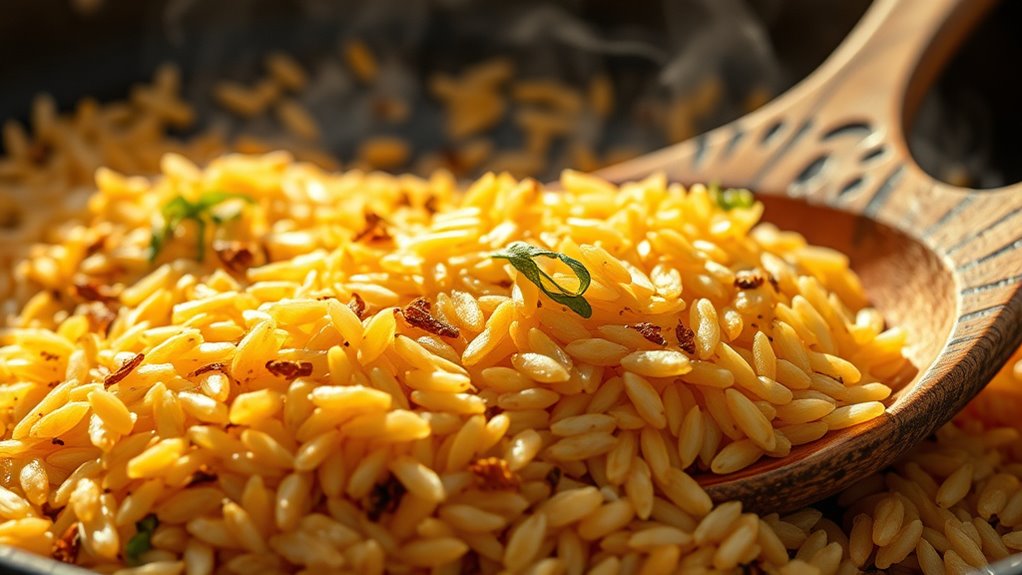
Toasting rice before cooking is a game-changer for enhancing flavor and aroma. This simple technique adds a delightful nutty scent and improves texture, making your rice dishes stand out.
Here’s how to toast rice effectively:
- Heat a tablespoon of oil in a pot.
- Add rinsed rice and stir continuously.
- Watch for the grains to turn golden brown, which takes about 3-5 minutes.
This method works wonders for basmati and jasmine rice, complementing their natural fragrances.
After toasting, just add your cooking liquid and follow your usual method. You’ll be amazed at how toasting rice can enhance flavor and transform your meals into something truly special!
Season Rice With Salt
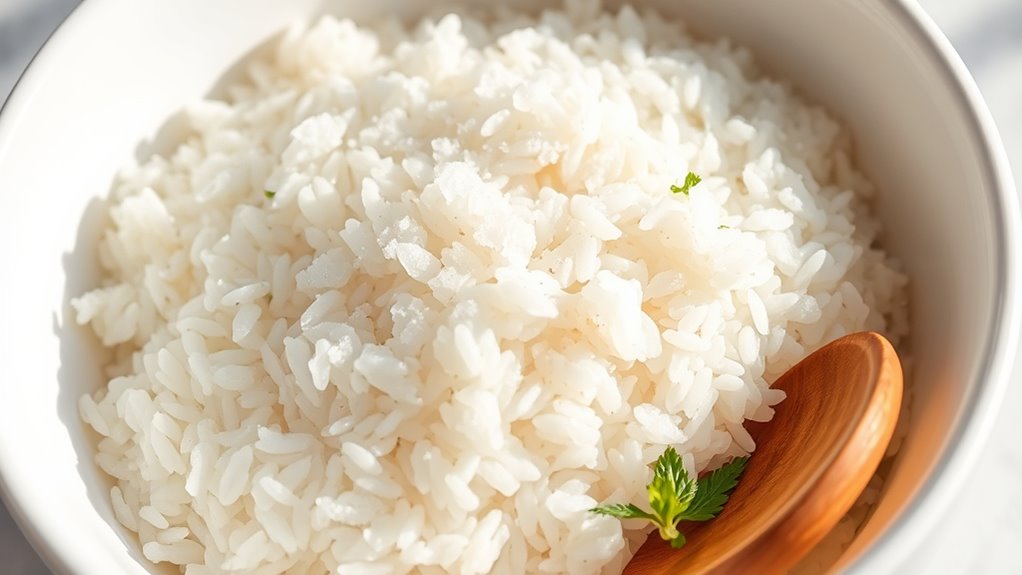
Seasoning rice with salt is a simple yet effective way to elevate its flavor, ensuring each grain is deliciously palatable. Adding salt during cooking infuses the flavor throughout the rice, rather than just coating the surface. You can adjust the amount of salt to suit your taste, typically using 1/2 to 1 teaspoon per cup of rice. Incorporating different salts can lead to exciting new flavors in your rice dishes!
| Salt Type | Flavor Profile | Use Cases |
|---|---|---|
| Table Salt | Basic, straightforward | Everyday rice dishes |
| Sea Salt | Briny, mineral notes | Gourmet rice preparations |
| Himalayan Salt | Slightly sweet, earthy | Unique flavor twist |
| Flavored Salts | Variety of tastes | Specialty dishes |
Experimenting with different salts can lead to exciting new flavors in your rice dishes!
Use a Kitchen Towel Under the Lid

Using a kitchen towel under the lid can greatly improve your rice’s texture, preventing that frustrating sogginess. By absorbing excess moisture, the towel guarantees your rice comes out light and fluffy.
Here’s how to do it effectively:
- Place a clean, thin cotton kitchen towel between the pot and the lid during the final cooking stages.
- This technique works for all rice types, like long grain, basmati, and jasmine.
- Drape the towel over the pot before covering it with the lid to trap moisture without direct contact with the flame.
- Letting the rice rest for 10-15 minutes with the towel helps redistribute moisture evenly throughout the grains.
Give this simple hack a try for perfectly cooked rice every time!
Let Rice Rest After Cooking
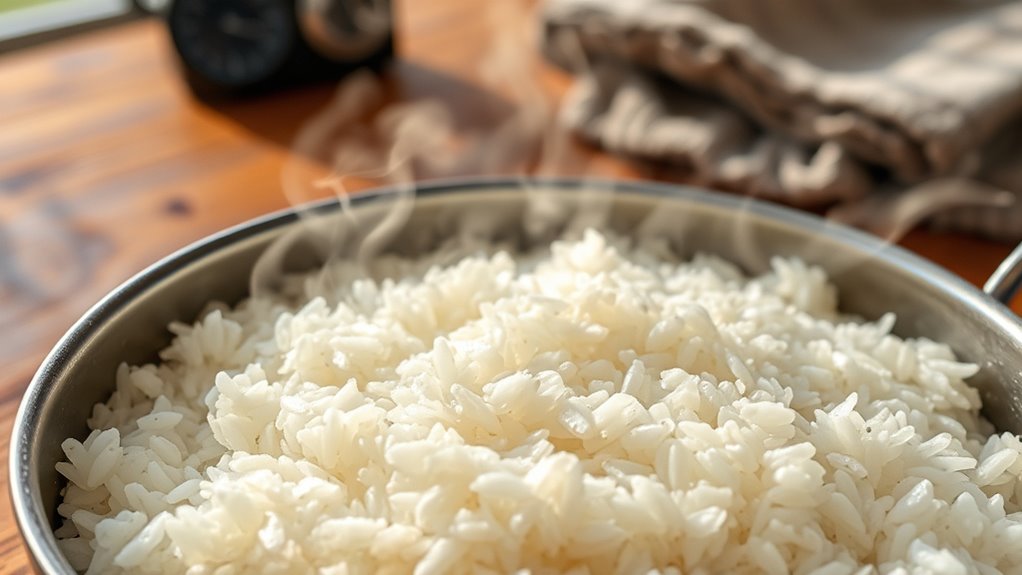
After utilizing a kitchen towel under the lid, letting your rice rest for about 15 minutes is another essential step for achieving that perfect texture. This resting period allows steam to continue cooking the rice gently, redistributing moisture for consistent, fluffy grains. It’s vital for achieving ideal separation, enhancing both presentation and taste.
| Step | Action | Benefit |
|---|---|---|
| Let the rice rest | 15 minutes | Redistributes moisture |
| Use a kitchen towel | Under the lid | Absorbs excess moisture |
| Enjoy your meal | Serve after resting | Improves overall satisfaction |
Frequently Asked Questions
What Is the 5 5 10 Rule for Rice?
The 5 5 10 rule for rice is a straightforward cooking method that helps you achieve perfectly cooked rice.
You start with 5 cups of water, add 5 cups of rinsed rice, and let it simmer for 10 minutes.
After that, you should let the rice rest off the heat for another 10-15 minutes.
This technique guarantees even moisture absorption without mushiness, making it easier for you to get consistent results every time.
What Is the 123 Rice Rule?
Did you know that nearly half of the world’s population relies on rice as a staple food?
The 1-2-3 Rice Rule is your go-to guideline for cooking perfect white rice. It suggests using 1 part rice to 2 parts water, ensuring fluffy grains.
Keep in mind that different rice types may require slight adjustments. For instance, brown rice often needs 2.5 to 3 parts water.
Master this rule, and you’ll elevate your rice cooking skills!
Does the Rice Hack Work?
Yes, the rice hack works! When you rinse your rice, you remove excess starch, resulting in less stickiness and a better texture.
Using a kitchen towel under the lid during resting helps absorb moisture, making your rice fluffier. Toasting rice in oil before cooking enhances flavor, while boiling brown rice like pasta simplifies the process and improves texture.
Even adding a splash of coconut oil can boost nutrition and reduce calories. Give it a try!
How Do You Cook Rice so the Grains Separate?
Did you know that nearly 50% of the world’s population relies on rice as a staple food?
To cook rice so the grains separate, start by rinsing it thoroughly to remove excess starch. Use a 1:2 water-to-rice ratio and add a splash of oil for texture.
Avoid stirring while it cooks, and after it’s done, let it rest covered for 10-15 minutes. This helps achieve perfectly fluffy, non-sticky grains.
Conclusion
By mastering these rice hacks, you can elevate your meals and make every grain count! Did you know that the average person consumes about 20,000 grains of rice a year? That’s a lot of potential for deliciousness! So, whether you’re trying a new variety or perfecting your cooking technique, remember these tips to enhance flavor and texture. Enjoy every bite, and impress your family and friends with your newfound rice expertise!









